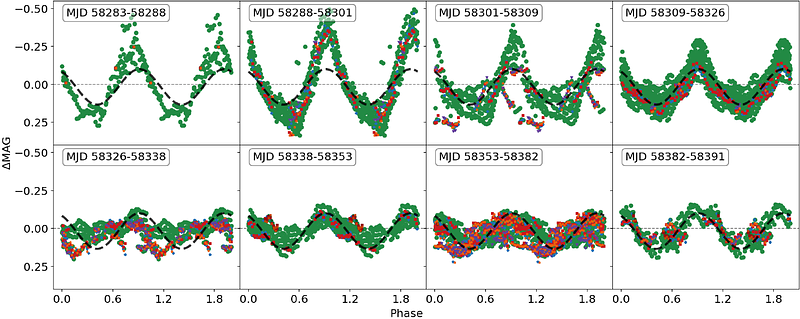Optical and X-ray timing analysis of the 2018-2020 outburst and rebrightening of the black-hole transient MAXI J1820+070

Optical and X-ray timing analysis of the 2018-2020 outburst and rebrightening of the black-hole transient MAXI J1820+070
M. Fiori, L. Zampieri, A. Burtovoi, G. Naletto, P. Ochner, U. Munari, F. Manzini, A. Vagnozzi, E. A. Barsukova, M. A. Burlak, V. P. Goranski, N. P. Ikonnikova, N. A. Katysheva, E. G. Sheyanov, S. Yu. Shugarov, A. V. Zharova, A. M. Zubareva, S. E. Motta
AbstractWe report the results of a comprehensive analysis of the multiwavelength (in optical and X-rays) and multitimescale (from months to tenths of a second) variability of the 2018-2020 outburst of the black hole transient MAXI J1820+070. During the first outburst episode, a detailed analysis of the optical photometry shows a periodicity that evolves over time and stabilises at a frequency of $1.4517(1)$ $1/d$ ($\sim0.5\%$ longer than the orbital period). This super-orbital modulation is also seen in the X-rays for a few days soon after the transition to the high-soft state. We also observed optical Quasi-Periodic Oscillations (QPOs), which correspond to some of the QPOs observed in X-rays at three different epochs when the source was in the low-hard state. In two epochs, optical QPOs with a centroid consistent with half the frequency of the most prominent X-ray QPO can be seen. If the lowest modulation frequency is the one observed in the optical, the characteristic precession frequency of MAXI J1820+070 is lower than that inferred from the `fundamental' QPO in the X-rays. Assuming that QPOs can be generated by Lense-Thirring precession, we calculate the spin of the black hole in the case where the fundamental precession frequency is tracked by the optical emission. We find a relatively slowly spinning black hole with a spin parameter $\lesssim 0.15$. The super-orbital optical and X-ray modulations observed after the disappearance of the QPOs may be triggered by the self-irradiation of the outer disc by a standard inner disc truncated at a few gravitational radii.